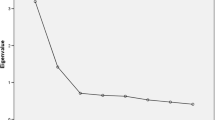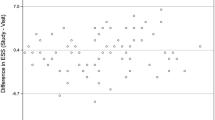Abstract
Purpose
The main purpose of this study was to develop a cross-cultural adaptation of the Epworth Sleepiness Scale for Peruvian population (ESS-VP) and to provide evidence of reliability and validity to this scale. We also modified the ESS-VP for non-driving Peruvian population (ESS-MPV).
Methods
Participants were Peruvians between 18 and 65 years. Five-phase design: Translation and retranslation of the original scale; comprehension evaluation (n = 60); reliability or test–retest (n = 75); internal consistency and construct validity (n = 219); and change of sensibility (n = 36). Just as in the ESS-PV, the same procedure was applied to ESS-MPV except the first phase.
Results
The ESS-PV and ESS-MPV had an adequate comprehension. They were reliable over time (test–retest), being better within a period of 2 weeks. They also had adequate internal consistency (Cronbach's alpha: 0.790 and 0.789). Two factors were extracted in both scales, being only the first factor in which all items showed statistically significant loads. Both scales are sensitive to sleepiness change in patients with obstructive sleep apnea during treatment.
Conclusions
The ESS-VP and ESS-MPV, adapted to adult Peruvian population, are comparable to the original scale, reliable, valid, and change-sensitive. It is proposed that the ESS-MPV should be applied in Peruvian population who do not drive motorized vehicles
Similar content being viewed by others
References
Roehrs T, Carskadon MA, Dement WC, Roth T (2005) Daytime Sleepiness and alertness. In: Kryger MH, Roth T, Dement WC, editors. Principles and Practice of Sleep Medicine. 4th ed: Saunders;p.39–49.
Ohayon M (2006) Epidemiology of excessive daytime sleepiness. Sleep Med Clin 1:9–16
Rey de Castro J, Alvarez J, Gaffo A (2005) Síntomas relacionados a trastornos del sueño en supuestos sanos que asisten a un centro de Atención Primaria de Salud. Rev Med Hered 16(1):31–38
Rey de Castro J, Gallo J, Loureiro H (2004) Cansancio y somnolencia en conductores de ómnibus y accidentes de tránsito en el Perú: estudio cuantitativo. Rev Panam Salud Pública 16(1):11–18
Rosales E, Egoavil M, La Cruz C, Rey de Castro J (2007) Somnolencia y calidad del sueño en estudiantes de medicina de una universidad peruana. An Fac Med Lima 68(2):150–158
Johns MW (1991) A new method for measuring daytime sleepiness: the Epworth sleepiness scale. Sleep 14(6):540–545
Schlosshan D, Elliott MW (2004) Sleep. 3: clinical presentation and diagnosis of the obstructive sleep apnoea hypopnoea syndrome. Thorax 59(4):347–352
Harsh J, Peszka J, Hartwig G, Mitler M (2000) Night-time sleep and daytime sleepiness in narcolepsy. J Sleep Res 9(3):309–316
Teodorescu M, Consens FB, Bria WF, Coffey MJ, McMorris MS, Weatherwax KJ, Durance A, Palmisano J, Senger CM, Chervin RD (2006) Correlates of daytime sleepiness in patients with asthma. Sleep Med 7(8):607–613
Hughes K, Glass C, Ripchinski M, Gurevich F, Weaver TE, Lehman E, Fisher LH, Craig TJ (2003) Efficacy of the topical nasal steroid budesonide on improving sleep and daytime somnolence in patients with perennial allergic rhinitis. Allergy 58(5):380–385
Craig TJ, Mende C, Hughes K, Kakumanu S, Lehman EB, Chinchilli V (2003) The effect of topical nasal fluticasone on objective sleep testing and the symptoms of rhinitis, sleep, and daytime somnolence in perennial allergic rhinitis. Allergy Asthma Proc 24(1):53–58
Chellappa SL, Araujo JF (2006) Excessive daytime sleepiness in patients with depressive disorder. Rev Bras Psiquiatr 28(2):126–129
Peres MF, Stiles MA, Siow HC, Silberstein SD (2005) Excessive daytime sleepiness in migraine patients. J Neurol Neurosurg Psychiatry 76(10):1467–1468
Matsui H, Nishinaka K, Oda M, Hara N, Komatsu K, Kubori T, Udaka F (2006) Excessive daytime sleepiness in Parkinson disease: a SPECT study. Sleep 29(7):917–920
Malow BA, Bowes RJ, Lin X (1997) Predictors of sleepiness in epilepsy patients. Sleep 20(12):1105–1110
Malcolm R, Myrick LH, Veatch LM, Boyle E, Randall PK (2007) Self-reported sleep, sleepiness, and repeated alcohol withdrawals: a randomized, double blind, controlled comparison of lorazepam vs gabapentin. J Clin Sleep Med 3(1):24–32
Perez-Chada D, Videla AJ, O'Flaherty ME, Palermo P, Meoni J, Sarchi MI, Khoury M, Duran-Cantolla J (2005) Sleep habits and accident risk among truck drivers: a cross-sectional study in Argentina. Sleep 28(9):1103–1108
Chiner E, Arriero JM, Signes-Costa J, Marco J, Fuentes I (1999) Validation of the Spanish version of the Epworth sleepiness scale in patients with a sleep apnea syndrome. Arch Bronconeumol 35(9):422–427
Chica H, Escobar F, Eslava J (2007) Validación colombiana de la escala de somnolencia de Epworth. Rev Salud Pública 9:558–567
Ferrer M, Vilagut G, Monasterio C, Montserrat JM, Mayos M, Alonso J (1999) Measurement of the perceived impact of sleep problems: the Spanish version of the functional outcomes sleep questionnaire and the Epworth sleepiness scale. Med Clin (Barc) 113(7):250–255
Rosales E, Egoavil M, La Cruz C, Rey de Castro J (2008) Somnolencia y calidad de sueño en estudiantes de medicina durante las prácticas hospitalarias y vacaciones. Acta Med Per 25(4):199–203
Dirección General de Circulación Terrestre – Ministerio de Transporte y Comunicaciones. Perú: Personas con Licencia de Conducir por Clase – Categoría, según región o departamento - 2005. [cited 24 de febrero del 2007]; Available from: http://www.mtc.gob.pe/estadisticas/archivos/xls/3.H.3.xls
Instituto Nacional de Estadística e Informática. Perú: Población Total: 1940 – 2005. [cited 24 de febrero del 2007]; Available from: http://www.inei.gob.pe/perucifrasHTM/inf-dem/cua1.htm.
Johns M, Hocking B (1997) Daytime sleepiness and sleep habits of Australian workers. Sleep 20(10):844–849
Hair J, Rolph A, Tatham R, Black W (1999) Análisis Multivariable, 5th edn. Prentice Hall, España
Ballard RD (2008) Management of patients with obstructive sleep apnea. J Fam Pract 57(8 Suppl):S24–S30
Guillemin F, Bombardier C, Beaton D (1993) Cross-cultural adaptation of health-related quality of life measures: literature review and proposed guidelines. J Clin Epidemiol 46(12):1417–1432
Patrick DL, Sittampalam Y, Somerville SM, Carter WB, Bergner M (1985) A cross-cultural comparison of health status values. Am J Public Health 75(12):1402–1407
Sanchez R, Echeverry J (2004) Validación de escalas de medición en salud. Rev Salud Pública 6:302–318
Sanchez R, Gómez C (1998) Conceptos básicos sobre validación de escalas. Rev Col Psiquiatría 27:121–130
Streiner D, Norman G (1994) Health measurement scales. A practical guide to their development and use, 1st edn. Oxford University Press, New York
Johns MW (1992) Reliability and factor analysis of the Epworth Sleepiness Scale. Sleep 15(4):376–381
Hernandez C, Abreu J, Abreu P, Colino R, Jimenez A (2006) Effects of nasal positive airway pressure treatment on oxidative stress in patients with sleep apnea-hypopnea syndrome. Arch Bronconeumol 42(3):125–129
Monasterio C, Vidal S, Duran J, Ferrer M, Carmona C, Barbe F, Mayos M, Gonzalez-Mangado N, Juncadella M, Navarro A, Barreira R, Capote F, Mayoralas LR, Peces-Barba G, Alonso J, Montserrat JM (2001) Effectiveness of continuous positive airway pressure in mild sleep apnea-hypopnea syndrome. Am J Respir Crit Care Med 164(6):939–943
Barnes M, Houston D, Worsnop CJ, Neill AM, Mykytyn IJ, Kay A, Trinder J, Saunders NA, Douglas McEvoy R, Pierce RJ (2002) A randomized controlled trial of continuous positive airway pressure in mild obstructive sleep apnea. Am J Respir Crit Care Med 165(6):773–780
Engelman H, Martín S, Deary I, Douglas N (1997) Effect of CPAP therapy on daytime function in patients with mild sleep apnoea/hypopnoea syndrome. Thorax 52:114–119
Wiggins CL, Schmidt-Nowara WW, Coultas DB, Samet JM (1990) Comparison of self- and spouse reports of snoring and other symptoms associated with sleep apnea syndrome. Sleep 13(3):245–252
García-Lopez P, Capote-Gil F, Quintana-Gallego M, Fuentes-Pradera M, Carmona-Bernal C, Sánchez-Armengol A (2000) Valoración mediante escala de Epworth de la somnolencia diurna en pacientes con sospecha de síndrome de apneas obstructivas durante el sueño. Diferencias entre los pacientes y sus parejas. Arch Bronconeumol 36:608–611
Conflict of interest
The authors indicate no financial conflicts of interest.
Author information
Authors and Affiliations
Corresponding author
Appendix
Appendix
Appendix A. Epworth sleepiness scale—modified Peruvian version (version in Spanish)
Escala de Somnolencia Epworth
(Versión Peruana Modificada)
¿Qué tan probable es que usted cabecee o se quede dormido en las siguientes situaciones? No se refiere a sentirse cansado debido a actividad física. Aunque no haya realizado últimamente las situaciones descritas, considere como le habrían afectado. Use la siguiente escala y marque con una X la opción más apropiada para cada situación:
-
Nunca cabecearía
-
Poca probabilidad de cabecear
-
Moderada probabilidad de cabecear
-
Alta probabilidad de cabecear
Situación | Probabilidad de cabecear | |||
|---|---|---|---|---|
Nunca | Poca | Moderada | Alta | |
Sentado leyendo | ||||
Viendo televisión | ||||
Sentado (por ejemplo en el teatro, en una reunión, en el cine, en una conferencia, escuchando la misa o el culto) | ||||
Como pasajero en un automóvil, ómnibus, micro o combi durante una hora o menos de recorrido | ||||
Recostado en la tarde si las circunstancias lo permiten | ||||
Sentado conversando con alguien | ||||
Sentado luego del almuerzo y sin haber bebido alcohol | ||||
Conduciendo el automóvil cuando se detiene algunos minutos por razones de tráfico | ||||
Parado y apoyándose o no en una pared o mueble | ||||
¿Usted maneja vehículos motorizados (auto, camioneta, ómnibus, micro, combi, etc.)?:
() SI () NO
Gracias por su cooperación
Rights and permissions
About this article
Cite this article
Rosales-Mayor, E., Rey de Castro, J., Huayanay, L. et al. Validation and modification of the Epworth Sleepiness Scale in Peruvian population. Sleep Breath 16, 59–69 (2012). https://doi.org/10.1007/s11325-011-0485-1
Received:
Revised:
Accepted:
Published:
Issue Date:
DOI: https://doi.org/10.1007/s11325-011-0485-1




